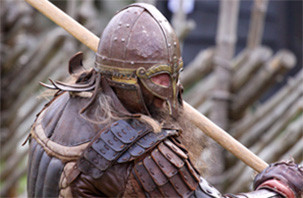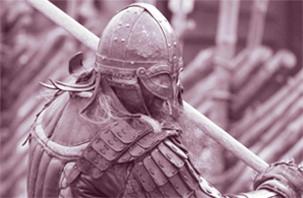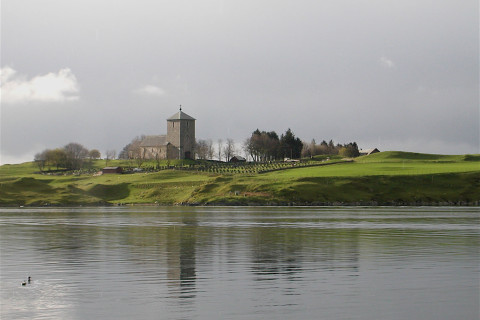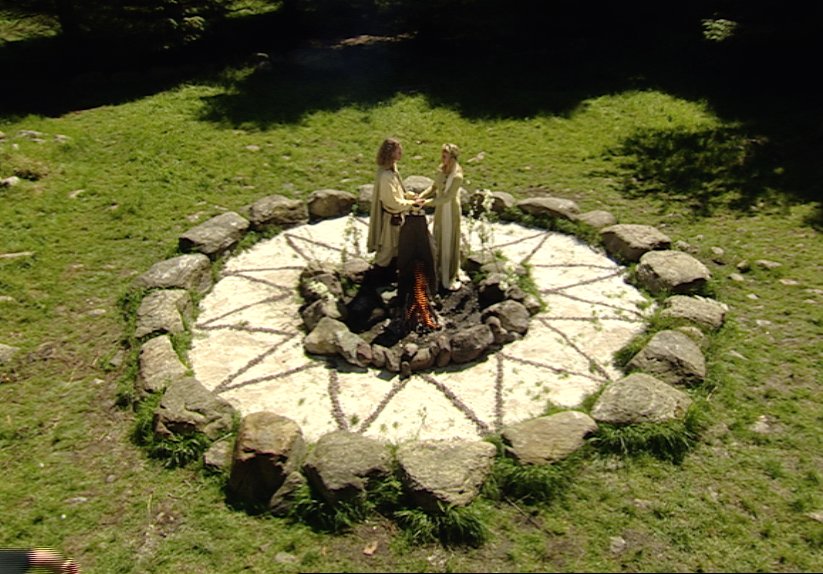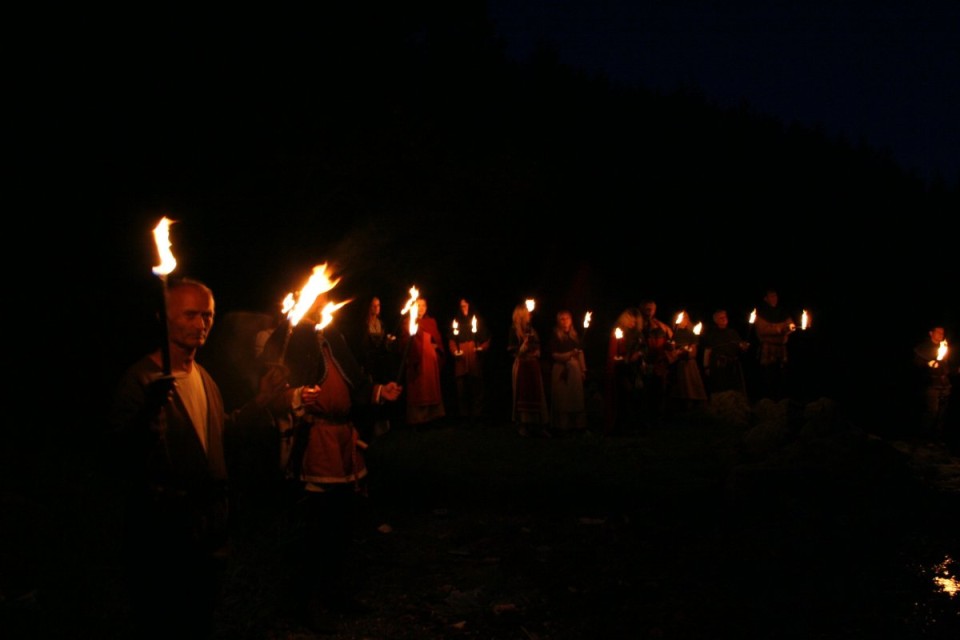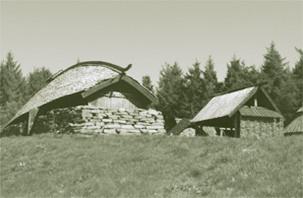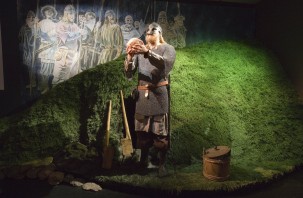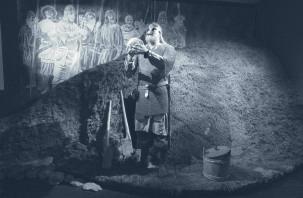Love and marriage
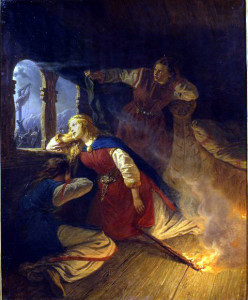
Hagbard and Signe.
Their love is forbidden. They can not have each other because their families are in conflict. Hagbard and Signe therefore choose to go to their deaths together (Ill. J.W. Wallander 1861)
Text Marit Synnøve Vea
MARRIAGE – A POLITICAL AND ECONOMIC AGREEMENT BETWEEN FAMILIES
Marriage was, at least among the wealthy, a family affair. Marriag was meant to create ties and alliances. The motives could be practical, economic or political. Love had little to do with it.
FORCED MARRIAGES WERE UNUSUAL
The laws did not require the woman’s consent when the marriage was entered into, but the sagas tell that it was common practice for fathers to consult their daughters. According to the sagas, it normally ended in a divorce or by the death of her husband if a woman was forced into a marriage.
MARRIAGE
Marriages had two stages: betrothal (festarmål) and the wedding ceremony (brudlaup). We know more about the betrothal than the actual wedding, because it was then the legally binding agreements were signed.
Betrothal (ON festarmál) feste means to make agreements for a marriage). Festarmål can be compared with more recent engagement, but it was a legally binding agreement between two families. The festarmål was therefore in many ways more important than the actual wedding.
Wedding (ON brúdlaup) = ( brúdlaup means to run home with the bride). The wedding was a feast that lasted for many days, where family and friends celebrated the effectuation or confirmation of the festarmål/betrothal. The festar-man (the groom) and the festar-møy (the bride) were led to a common bedding, where they for the first time (officially) should share a bed.

Gold bracteate which probably shows the marriage between Frey and Gerd. Such bracteates were often placed under the roof-bearing beams in longhouses, perhaps as a sacrifice in order to protect house and people. (Photo AmS)
WEDDING RITUALS
We know little about the actual wedding rituals, but we can find some indications in the myths and from traditional Norwegian wedding ceremonies that might have been continued from the Norse period.
On gold bracteates (thin pieces of beaten gold) we see that loving couples are depicted with a ring and a rod or branch. In the myth of Gerd and Frey, we hear that Skirne brings with him apples and the ring Draupne to lure the giant’s daughter Gerd to say yes to Frey’s marriage proposal. He also has with him a rod engraved with runes.
We can imagine that a rod (perhaps carved with auspicious runes) or a branch (perhaps birch symbolizing fertility), was part of a wedding ritual. As were probably apples that were fertility symbol and a ring which symbolized birth, death and rebirth.
In Norwegian folklores and tradition we find wedding formulae that seem to be ancient. I.e., “He weds you to honour and to be the lady of the house, to half the bed and to locks and keys … under one blanket and one sheet.” Perhaps these words go far back in time.
The word brúdlaup indicates that the wedding guests accompanied the bride and groom to bed. For a long time this was the case in the Norwegian countryside. It was the highlight of the wedding party when guests with fiddler, drummer, bridesmaids and groomsman followed the bride and the groom to bed where the couple lay down “under one blanket and on one sheet.”
Another sample from tradition: Before the groom walked out of the living room where the wedding feast was held, he beat three hard blows with his sword in a beam (called the “bride cut”). On the way to the bridal chamber the guests carried torches and bridal-lights. When the groomsman walked through the door of the bridal chamber, he shut it again three times with all his strength. This was called the “bride bang” – but no one knows why.
WEDDING SUITS
There is no evidence that the bride and groom had special wedding clothes beyond that they probably were dressed in their best finery. The exception may be that the bride wore “bridal linen” on her head.

Thor is dressed up in nice clothes and a bridal-linen to “marry” the giant Thrym – who thinks he is marrying Freya. This is something Thor must do to regain his hammer Mjørnir.. (Illustration by Carl Larsson)
In Thrymskviða we hear that Thor – the god of thunder – puts on nice clothes and a bridal-linen before he disguised as Freya go to Thryms farm to “marry” with the giant. When they sit at the table to drink brudlaup, Thrym lifts the veil to kiss the “bride”. We can assume that the bridal-linen covered the face. If not, the giant would have discovered that the “bride” was the wrong person and the wrong gender
(..)
Bind we on Thor
the bridal veil,
Let him bear the mighty
Brisings’ necklace;
Keys around him
let there rattle,
And down to his knees
hang woman’s dress;
With gems full broad
upon his breast,
And a pretty cap
to crown his head.”
(…)

“Harald proposes to Gyda”. Gyda refuses to marry Harald Fairhair before he united Norway into one kingdom. (Painting by Knut Berg Lien, 827-1908
Thrym looked ‘neath the veil,
for he longed to kiss,
But back he leaped
the length of the hall.
Why are so fearful
the eyes of Freyja?
Fire, methinks,
from her eyes burns forth.…
DIVORCES AND THE LIBERTY OG WOMEN
When a woman married, she brought a dowry with her into the marriage. The groom gave her a similar amount as a “morning gift”. In case of a later divorce, the woman could keep both parts. In sagas we meet many women who have been divorced and married many times.
An Arabian emissary , At –Tartuschi, that visited Denmark around 970 AD reports: “The women have the right to ask for a divorce. They get divorced whenever they want to”.

“Óðr again leaves the grieving Freyja”. While she waits for him to come back, she cries tears of gold.. (Wikimedia Commons)
An Arabian poet, Al Ghazal, wrote that he was on a ship that was sailing to the North in company with a Viking ship. Both were going to “the king of the pagans on a large island in the ocean”. (It is conjectured that he could have been referring to a new Norwegian community in Ireland or somewhere in Denmark or Norway). “Dressed in finery and in a hall filled with valuable objects and weapons” the “king of the pagans” received Al Ghazal.
Al Ghazal wrote that that he was often the guest of the pagan king’s wife and had long conversations with her, with the help of an interpreter. He told her of the countries far south and about the people of Muhammed and their history. In gratitude for these stories, she sent him gifts, nice meals, clothes and perfumes.
The writer told her that he was afraid that there would be gossip, since the two of them spent so much time together. She then consoled him by telling him of the freedom enjoyed by the women of the northern peoples:
“It is not our custom to be jealous” and “In our country, a woman can leave her husband if she no longer likes him”.
LOVE IN THE VIKING AGE
Marriages were arranged between families and love was seldom part of it. Still, people found love both inside and outside the marriage. Sagas, Norse poems and myths are filled with passionate love stories. This is also reflected in Norse mythology. Mythology and ancient poems indicate that those who have loved deeply could be reborn.

“Helge takes goodbye with Sigrun. ” Helge Hundingsbane and Sigrun were reborn as Helge Haddingjaskate og Kåra Halvdansdotter. They had also lived together in a former life, then they were called Helge Hjorvardson og Svåva. I.e they lived three lives together – because of love. (Painting by Ernest Wallcousins, 1883)
Helge Hundingsbane and Sigrun
In the Norse poem about Helge Hundingsbane, Helge had to fight Sigrun’s family in order to win her, because she had been promised to another man. It was told that Sigrun had been a shield maiden (Valkyrie) and had helped Helge to kill Hunding. Afterwards, “Hogne’s daughter Sigrun swept down to Helge, caught hold of the young king’s hand, kissed him and aroused his love.”
She told him that she had loved him for a long time, had followed him and helped him, together with other shield maidens. Later, when Sigrun’s brother Dag killed Helge, Sigrun cursed her brother.
After Helge’s death, Sigrun built a great burial mound over him and went there every day to mourn. One day, Helge showed himself to her and they spent the night together inside the burial mound.
Here a bed I have made for thee, Helgi,
To rest thee from care, thou king of the Ylfings;
I will make thee sink to sleep in my arms,
As once I lay with the living king.”
(The Second Lay of Helgi Hundingsbane )
In the morning Helge asks her to stop mourning, because her tears prevent him from finding peace. Then he must ride to Valhalla, and Sigrun understands that she will never see him again. Shortly after Sigrun dies of grief.
It is said that Helge and Sigrun were reborn as Helge Haddingjaskate og Kåra Halvdansdotter. They had also lived together in a former life, then they were called Helge Hjorvardson og Svåva. I.e they lived three lives together – because of love.
Oddrun’s lament
This ancient poem tells how king Atle refused to allow his sister Oddrun to marry the man she loved. “You cannot force me to stop loving him”, said Oddrun, “I left my head on my hero’s breast”.
Gerd og Frey
Also the gods could fall in love.

“Svipdagr and Menglöð”. Svipdag gets help from his dead mother, the volve Groa, to be reunited with Menglød. (W.G. Collingwood, 1908.)
One deay Frey, the god of fertility, sat in Odin’s high-seat looking out over the world. Towards the north he caught sight of the most beautiful woman he has ever seen. It was Gerd, the daughter of the mountain giant Gyme. When Gerd raised her arms, the whole sky gleamed (that’s how the northern lights are created). Frey fell deeply in love; he could not talk, sleep or eat. He was filled with melancholy and only wanted to die, if he could not have her
Frey’s friend Skirne was therefore sent to Gerd to propose to her on Frey’s behalf and after much trial and tribulation, she finally consented to marry him. They agreed that Gerd should come to him after nine nights had passed. While he waited, Frey complained:
Long is one night
Two is even worse
How can I manage three?
Often a month
seemed shorter to me
than half this night without my bride(Skirnismál)
LOVE IN MARRIAGE
Some people certainly were in love before they married. Others learned to love each other.

Motif from an heroic saga.(Painting by P.N. Aarbo . Wikimedia Commons).
Harald Fairhair and Snøfrid
Harald Fairhair fell deeply in love with the Sami girl Snøfrid Svåsedotter.
“The king married Snøfrid and loved her so passionately that he neglected everything else, including his realm and all that he should have looked after in it.
Then Snøfrid died, but she did not change colour at all; she was just as pink as when she was alive. The king sat constantly watching her, believing that she would reawaken. He spent three years mourning her death and all his people sorrowed because of his madness”. (Saga of King Harald Fairhair)
Njál and Bergþóra
In Njál’s saga we meet Bergþóra who refuses the amnesty of those attacking her home, preferring to die with her husband Njál: She says “I was given to Njal in marriage when I was young, and I have promised him that we would share the same fate”
THE DANGER OF LOVE
It was forbidden by law to make mansongr or love poems. For such a poem a skald could be outlawed or risk a death penalty.
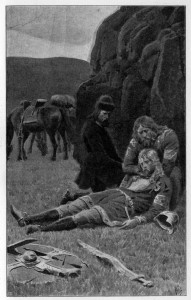
“Kjartan dies in Bolli’s arms”. Laksdøla saga tells about Kjartan and Bolli who both love Gudrun. This leads to their death. Gudrun is married four times. The first husband she divorces from, the others die. (Ill. Andreas Bloch, 1898).
There were probably two reasons for this:
– The love poem could destroy a woman’s reputation or insult her family
– The words had magical power that could enchant the woman mentioned
Still skalds made love poems. One of these skalds was Kormak who made many love poems to his beloved Steingerd, also after she had married another man. Another was Tormod Kolbrunarskal (skald of dark eyebrows) who got his nickname because he made love poems to a women with dark eyebrows.
Love outside marriage dangerous? Sex outside marriage accepted?
Where love, sex and adultery are concerned, Vikings seem to have had certain kind of double standard:.
– A man could be outlawed for making a love poem about a woman, and she could risk that her reputation was destroyed.
– On the other hand, a man could have several children with mistresses, and an unmarried women could have a child without this ruining her chances of getting married.
ADULTERY
We find the same double standards or contradictions expressed in the accounts of Adam of Bremen (1070 AD) .
Adam of Bremen tells that adultery was punished by death: “Men are sentenced to death for committing adultery, while women are sold as slaves. Rape of virgins is punishable by death.”
Nevertheless, men were permitted to take mistresses. The same Adam of Bremen wrote that: “Every man has two, three or more wives at the same time, depending on his wealth and fortune. Those who are rich and affluent have innumerable wives
TO SEEK LOVE ELSEWHERE
When the feelings of the bride and groom weren’t taken into consideration when two people married, you might expect that quite a few would seek love elsewhere, and they did.
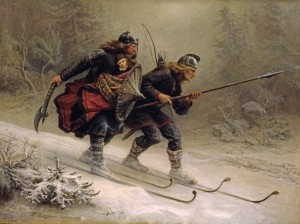
The Birchlegs take Prine Håkon Håkonsson across the mountain. Håkon’s mother Inga from Varteig, was King Sverre’s “frille” or mistress. (Painting by Knud Bergslien).
The sagas and the law confirm what Adam of Bremen says: It was in a way socially accepted that some men had mistresses or “friller”:
A frille
A frille was a long time mistress that lived together with a man at the same time as he had a wife. Sometimes these mistresses were of a lower class than the man, and therefore, a marriage between them was unacceptable. But sometimes these ladies were resourceful women, from the same social layer as the man she chose to connect with. A child of these concubines had the same rights to inherit as legitimate children.
What then about the women, did they have other lovers than their husbands? They probably did. But their husbands were regarded as the father of their children.
UNMARRIED WOMEN
The codex of morality was stricter for women than for men, but a woman who got a child outside marriage, was not expelled from her family, and it didn’t weaken her possibilities to get married.
If an unmarried woman got a child, the rule was that she could reveal the name of the father at the Thing (the place for law and justice). If he didn’t deny this, witnessed by some friends, he was recognized as the father.

“Freya”. Freya represented the erotic love. She could have any man she wanted, except the one she loved; her husband, the eternal wanderer Od. In her longing for Od Freyja cried tears of gold. (Ill. C. F. von Salza, 1893)
If the woman concealed who the father of her child was, it was believed that the father was a slave. The child then got the same status as its mother’s family.
Children that a slave woman got with her owner were counted as slaves. But the father could set the child free and foster it as his own.
SEXUALITY AND FERTILITY OF NATURE
In old fertility cults there was a clear distinction between male fertility and female fertility, often exemplified in a god of heaven and a goddess of earth. In pagan times desire and sex seem to have been looked upon as part of the universal fertility we find in nature itself. There were fertility rites that drew lines from sex and fertility among humans to the fertility in nature, with seeds that germinated and grew in the soil when it was heated by sunshine.
Far into modern times, we could find traces of “fertility magic” in Scandinavia. It is said that in some rural places in Norway, it was a custom that husband and wife on a farm would steel out and sleep together in the cornfield to secure a good harvest.
There were various types of fertility rituals. In Völsaþátt (St. Olav’s saga, Flateyarbok) Olav and his men come to a farm where they still hold Völseblot or Alveblot (= offerings to the elfs). Völsa is a cut off horse penis wrapped in linen, onion and herbs that conserve it, and it is kept and sung over during the völsablot.
The Christian chronicler’s description is characterized by the fact that he is opposed to this pagan custom. He describes the women as the leading players in the ritual that was closely associated with fertility and elves. Through what we can trace in Scandinavian place names and proper names, it seems that the elves have played a more important role in mythology, than the Christian saga-writers attribute to them. Perhaps this is because of their role in such a fertility cult?
In pagan times, the Scandinavians did’t seem to be ashamed of sexuality or desire. Promiscuity among women, on the other hand, was not approved, not even among goddesses. In a poem (Lokasenna) in the Poetic Edda, Loke insults Freya by saying that:

Phallus stones were also erected in the the landscape. One of the best known is the Dønna phallus from the Migration period. It is made of white marble. (Photo Wikemedia Commons)
Be silent, Freyja!
for fully I know you,
Sinless you are not, yourself.
Every god and every elf in her
Have been your lover.
THE VIKING MOTHER
Quite small children, especially boys from high status families, could be sent away to be fostered by others. This was a way of strengthening alliances between families. What then about the bounds and feelings between biological parents and children? They seem to have been very strong.
On a rune stone on Rimsø (ca 900 AD) we can read: “Thore, brother of Enride, erected this stone in memory of his mother. Death of a mother is the worst that can happen to a son”.
DELVERY WAS DANGEROUS
The delivery was dangerous, for the mother was well as for the child. Many women died young. Nevertheless, there were more women who died in childbed fever in the 1800s than in the Viking Age
On a runestone from Gotland we can read:
“Sibba erected this stone after Rotjud his wife, daugther of Rodgeir in Anga. She died young from 4 small children.”

Rune stone on Rimsø (ca 900 AD) “Thore, brother of Enride, erected this stone in memory of his mother. Death of a mother is the worst that can happen to a son”. (Photo Wikimedia Commons)
THE VIKING CHILD
Infant mortality during the Viking Age was very high. And a woman could only expect that half of her children grew up.
There are some accounts of children in the sagas, but we seldom run into children in the archaeological material. The few times we actually find children graves, you can sense the grief of their parents.
A very special grave from Gotland reveals this:
The baby girl from Fröjel.
The grave, dated to the 8th century, was found in an outer wall of an Iron Age fortress. It contained the burned bones of a babygirl, some glass beads, two bracelets and two animal shaped brooches. All the objects were “baby” size.
This very small jewellery is very uncommon. We must ask if this jewellery was especially made for this little baby girl. The grave shows all the care that has been given to this baby girl. And it shows the grief of her parets.
INFANTICIDE
When a baby was born, it was the father who decided if the new-born child should live, that is “be placed on his knee” and accepted as a full member of the family, with the rights and obligations this entailed. If not, the child had to “put out”. This meant that the child was placed out in nature, which in most cases led to death of the baby.
It was not honourable to place a child into the forest, but for some poor families, it might have been the only way to make the other children survive

Small children could be sent away to be fostered by others. This was a way of strengthening alliances between families. Still the bounds between biological parents and children seem to have been very strong. (Foto Marit S. Vea)
WOMEN ACCEPTED CHRISTIANITY BEFORE MEN
It is common to say that when Christianity was introduced in Scandinavia, women lost many of their rights. This is true for medieval women, but in the latter part of the Viking Age, that is in the transition period between paganism and Christianity, it appears that women became more visible in the public sphere than they had been before.
Women were among the first in the Viking Society to accept Christianity. Why? Perhaps they were attracted by the Christian prohibition of infanticide? In all cultures at all times; the most important thing for women has been to protect and care for their children.
Back
